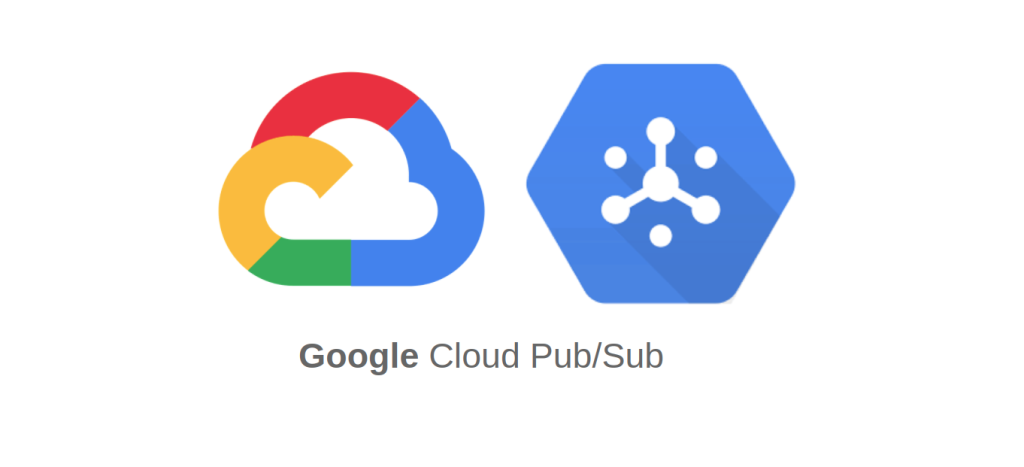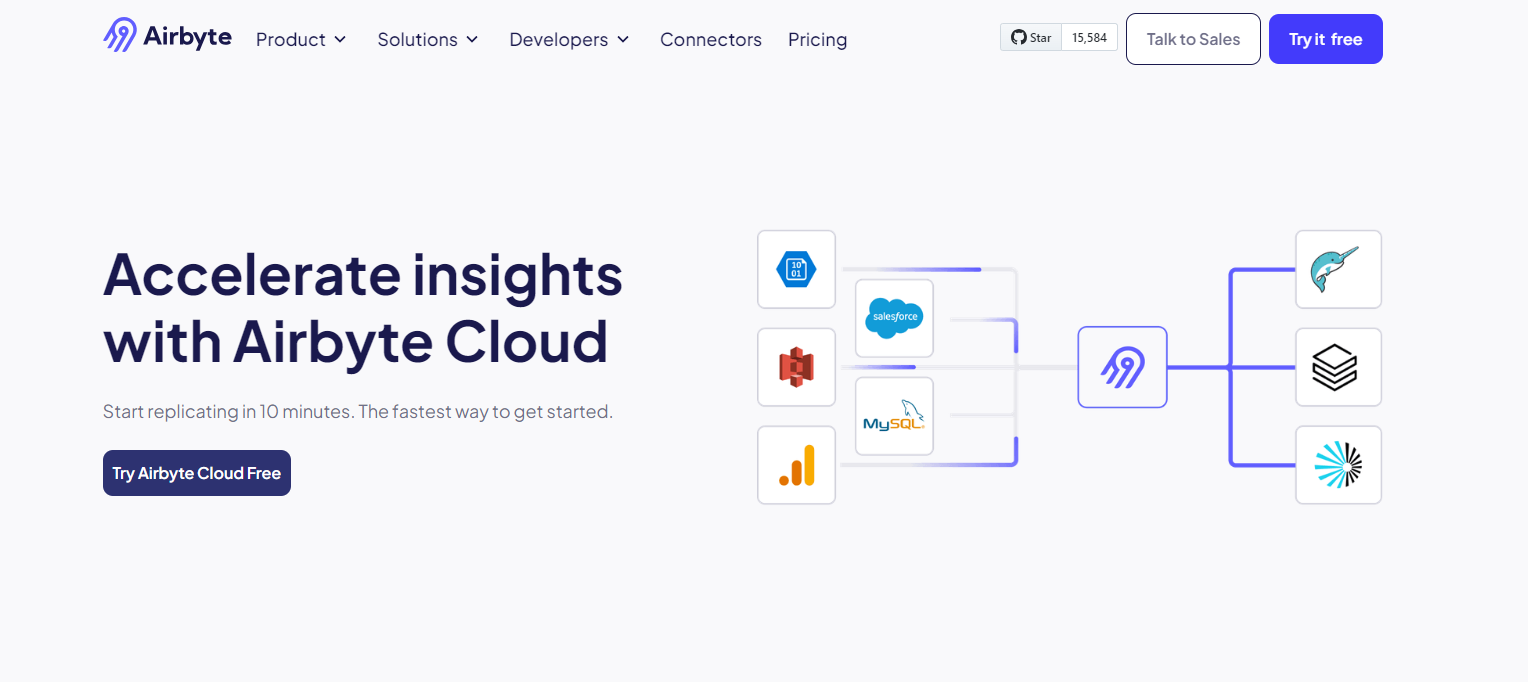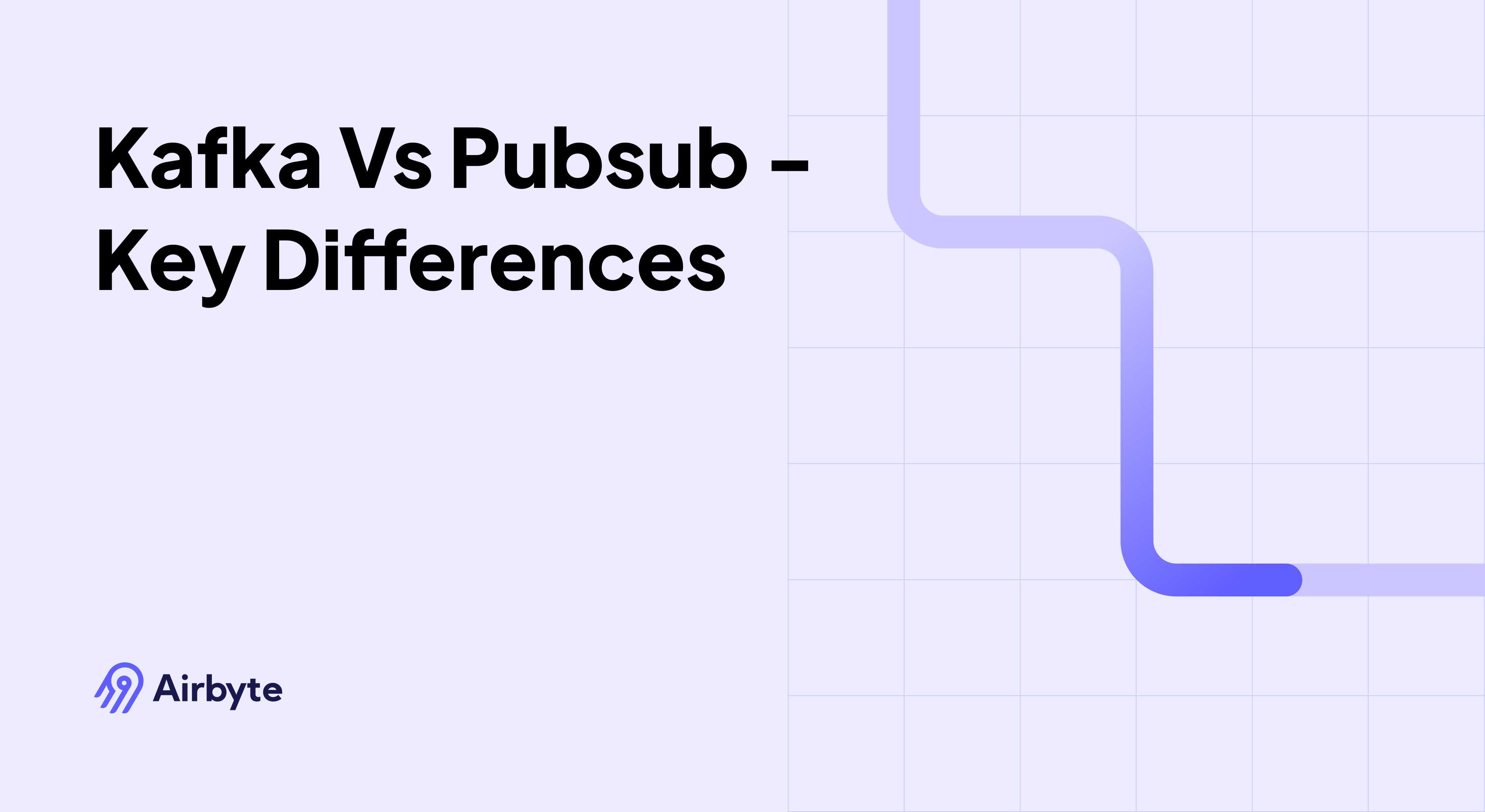Kafka Vs Pub/Sub - Key Differences
Summarize this article with:
✨ AI Generated Summary
Apache Kafka and Google Cloud Pub/Sub are leading streaming platforms with distinct architectures: Kafka offers granular control, ultra-low latency, and customizable deployments ideal for complex, stateful workflows, while Pub/Sub provides a fully managed, serverless solution with automatic scaling and simplified operations suited for cloud-native applications. Key differences include:
- Kafka: broker-centric, requires manual scaling and ops expertise, supports exactly-once delivery with strong cross-region durability, optimized for low latency and high throughput.
- Pub/Sub: serverless, auto-scales globally, offers regional exactly-once delivery, abstracts partitioning, and integrates tightly with Google Cloud services.
- Airbyte: simplifies data integration between Kafka, Pub/Sub, and other sources with 600+ connectors, flexible deployment, and enterprise-grade security, reducing operational complexity.
Data teams at growing enterprises face an impossible choice when selecting streaming platforms: continue using expensive, inflexible legacy systems that require dozens of engineers to maintain, or attempt complex custom integrations that consume resources without delivering business value. This fundamental problem affects how organizations handle real-time data processing, with Apache Kafka and Google Cloud Pub/Sub emerging as the two dominant solutions that take radically different approaches to solving enterprise streaming challenges.
Apache Kafka and Google Cloud Pub/Sub represent opposing philosophies in data streaming architecture. Kafka provides granular control over partitioning, replication, and processing through its open-source, broker-centric model, making it ideal for organizations requiring customizable, stateful workflows. Pub/Sub abstracts infrastructure management entirely, excelling in serverless, globally scalable implementations with minimal operational overhead. Understanding these architectural differences becomes critical as enterprises modernize their data infrastructure and choose platforms that will shape their streaming capabilities for years to come.
What is Apache Kafka?

Apache Kafka is an open-source, distributed event-streaming platform used to build real-time data pipelines. It captures data from sources like databases, applications, and IoT devices, then streams it to downstream systems or analytics platforms, ensuring a continuous flow of information across enterprise architectures.
Kafka's architecture centers on a broker-centric model where data streams are organized into topics subdivided into partitions. Each partition functions as an immutable, ordered log hosted across broker nodes, enabling fine-grained replication control and partition leadership distribution. The recent transition to KRaft mode eliminates ZooKeeper dependencies, simplifying cluster management while enhancing access governance and reducing attack surfaces.
Kafka's core components include:
- Producers – client applications that publish events to topic partitions
- Consumers – client applications organized in consumer groups that subscribe to and process events
- Brokers – servers that store partition data and manage replication across the cluster
- Topics – logical categories for events, divided into partitions for horizontal scalability and parallel processing
Key Features of Apache Kafka
- Advanced replication strategies – configurable replication factors ensure data durability across multiple brokers and regions, with in-sync replicas providing automatic failover capabilities during broker failures.
- Ultra-low latency processing – optimized batching, intelligent partitioning, and compression techniques maintain end-to-end latency below 5ms for high-throughput pipelines processing millions of messages per second.
- Enterprise-grade security – comprehensive protection including end-to-end encryption, mutual TLS authentication, OAuth2 integration, and granular ACL-based authorization controls that meet SOC 2 and regulatory compliance requirements.
- Stream processing capabilities – native Kafka Streams API enables real-time data transformations, windowed aggregations, and complex event processing directly within the Kafka ecosystem without requiring external frameworks.
What is Pub/Sub?

Google Cloud Pub/Sub is a fully managed, asynchronous messaging service that decouples message-producing services (publishers) from message-receiving services (subscribers). This architectural separation improves performance, scalability, and system resilience by enabling independent scaling of publishers and subscribers.
Pub/Sub operates as a globally distributed, serverless system with separate data and control planes. Publishers submit messages to topics, while subscribers receive them via subscriptions linked to those topics. Unlike Kafka's partition-centric model, Pub/Sub abstracts partitioning from users, dynamically sharding data across regions and automatically replicating messages across zones for resilience.
The platform handles messages in various formats including text, JSON, and binary data, storing them in Google's distributed infrastructure until at least one subscriber acknowledges receipt. This managed approach eliminates infrastructure provisioning and maintenance while providing automatic scaling capabilities.
Key Features of Pub/Sub
- Flexible delivery mechanisms – subscribers can pull messages on-demand or receive them pushed via HTTP(S) endpoints, enabling both batch and real-time processing patterns across diverse application architectures.
- Advanced filtering capabilities – subscribers can filter messages using attributes and expressions to process only relevant data, reducing computational overhead and improving processing efficiency.
- Global distribution and auto-scaling – automatic load balancing routes traffic to optimal data centers while handling millions of messages per second without manual intervention or capacity planning.
- Enterprise security integration – native VPC Service Controls, Customer-Managed Encryption Keys (CMEK), and fine-grained IAM roles provide comprehensive security frameworks that meet HIPAA, GDPR, and other regulatory requirements.
What Are the Key Architectural and Scalability Differences in Pub/Sub vs Kafka?
Key Architectural and Scalability Difference
- Kafka’s Broker Model: Kafka stores and routes data within brokers, giving fine-grained control over partitions, replication, and consumers. It scales by adding brokers and partitions, but this requires manual planning and can trigger rebalancing overhead. Tiered storage now helps offload older data to S3 or similar.
- Pub/Sub’s Serverless Model: Pub/Sub is fully managed, separating data and control planes for seamless scaling. It auto-balances traffic across Google’s global infra, handling millions of messages per second without partition management. Limits exist around regional quotas and message size, but failover and replication are automatic.
- Trade-offs: Kafka offers control and tuning at the cost of operational complexity. Pub/Sub emphasizes simplicity and elasticity but with less customization. The decision usually comes down to control vs convenience.
Exactly-Once Delivery Guarantees
- Kafka: Provides exactly-once semantics with idempotent producers, transactions, and consumer isolation. It supports atomic writes across partitions and ensures consumers only see committed data. With tuning, it maintains high throughput and low latency even under transactional loads.
- Pub/Sub: Introduced exactly-once in 2024, with regional guarantees enforced by acknowledgment IDs and deduplication windows. It prevents duplicate deliveries but doesn’t extend across regions. Performance is strong, though not as fast as Kafka in tightly tuned clusters.
- Integration Considerations: Cross-platform flows require careful connector setup and schema compatibility. Many teams still add app-level idempotency for safety.
Performance and Latency Differences
- Kafka: Optimized for low latency (1–5 ms) using zero-copy transfer, sequential disk I/O, and partition-based parallelism. It can hit ~850k msgs/sec with sub-ms latency when tuned. But it requires expertise in tuning and hardware optimization.
- Pub/Sub: Baseline latency is higher (50–100 ms) due to its global managed design, but it can scale to 100M+ msgs/sec. Limited tuning options, though batching, flow control, and regional endpoints help.
- Use Cases: Kafka fits ultra-low-latency scenarios like trading, IoT, and fraud detection. Pub/Sub suits workloads that tolerate moderate latency in exchange for scaling ease, like batch jobs, notifications, or cloud-native microservices.
Data Replication and Durability
- Kafka: Replication factors and acknowledgments are configurable. Users control durability vs performance trade-offs, with ISR (in-sync replicas) ensuring failover. Disaster recovery often involves MirrorMaker or cross-cluster replication, which requires expertise.
- Pub/Sub: Replicates messages across zones automatically before ack. Failover and recovery are managed by Google. Once messages are acknowledged, they’re removed, though replay is possible within retention windows.
- Trade-offs: Kafka offers flexibility but demands ops investment. Pub/Sub gives managed durability and resilience without user effort but less control.
Integration Ecosystems
- Kafka: Has 100+ connectors via Kafka Connect, spanning DBs, cloud storage, and enterprise apps. Schema Registry provides governance across Avro, JSON, and Protobuf. Strong for hybrid or multi-cloud data pipelines.
- Pub/Sub: Tightly integrated with Google Cloud services (BigQuery, Dataflow, Functions, Cloud Run). Supports event-driven and serverless designs with built-in observability.
- Cross-Platform: Hybrid setups use connectors to bridge Kafka and Pub/Sub, often standardizing on formats like Protobuf for schema compatibility.
Factors in Choosing
- Deployment: Kafka works on-prem, hybrid, or any cloud but requires ops. Pub/Sub is Google-only but managed.
- Scalability: Kafka gives tuning control; Pub/Sub autoscales effortlessly.
- Cost: Kafka infra costs grow steadily; Pub/Sub’s pay-per-use favors bursty workloads but can spike for constant high volume.
- Expertise: Kafka requires distributed systems skills. Pub/Sub reduces ops burden but limits customization.
- Use Cases: Kafka is best for low-latency, stateful processing; Pub/Sub fits cloud-native, event-driven apps.
How Can You Streamline Data Integration with Airbyte?

Once you decide between Kafka and Pub/Sub, you still need to move data from diverse sources into your chosen platform. Airbyte eliminates the traditional trade-offs that force organizations to choose between expensive, inflexible proprietary solutions and complex, resource-intensive custom integrations. With an ever-growing library of 600+ connectors, you can efficiently load data from Kafka to Pub/Sub or vice-versa without writing custom code or managing complex infrastructure.
Airbyte's open-source foundation addresses the fundamental cost and flexibility problems that limit data-driven innovation. Unlike traditional ETL platforms that require specialized expertise and create vendor dependencies, Airbyte generates open-standard code and provides deployment flexibility across cloud, hybrid, and on-premises environments while maintaining enterprise-grade security and governance capabilities.
Comprehensive Integration Capabilities
Airbyte's extensive connector ecosystem covers databases, SaaS applications, file systems, and streaming platforms including both Kafka and Pub/Sub. The platform's Connector Development Kit enables rapid custom connector creation for specialized requirements, significantly reducing integration development time from months to weeks. This approach eliminates the 30-50 engineers typically required to maintain basic data pipeline operations with legacy platforms.
The platform's no-code connector builder empowers business teams to create integrations without extensive technical expertise, while advanced users can leverage PyAirbyte for programmatic pipeline management and custom transformation logic. This flexibility enables organizations to scale integration capabilities across different skill levels and use cases.
Enterprise-Grade Security and Governance
Airbyte embeds comprehensive security and governance capabilities across all deployment options, supporting SOC 2, GDPR, and HIPAA compliance requirements without operational compromises. End-to-end data encryption, role-based access controls, and comprehensive audit logging ensure sensitive data remains protected throughout the integration process.
The platform's support for on-premises and hybrid deployments enables organizations to maintain data sovereignty while accessing modern integration capabilities. This approach proves particularly valuable for financial services, healthcare, and government organizations with strict data residency requirements.
Flexible Deployment and Operational Excellence
Airbyte offers multiple deployment options to match organizational preferences and requirements. Airbyte Cloud provides a fully-managed service with 10-minute setup and automatic scaling, while self-managed enterprise deployments offer complete infrastructure control with advanced governance features. The open-source edition enables maximum customization for organizations with specific technical requirements.
The platform's production-ready architecture processes over 2 petabytes of data daily with Kubernetes support for high availability and disaster recovery. Automated scaling and resource optimization reduce operational overhead while maintaining cost efficiency, enabling teams to focus on business value rather than infrastructure management.
Key Airbyte features include:
- Multiple pipeline-building options – Web UI, API, Terraform Provider, and PyAirbyte for different technical skill levels and use cases
- Flexible deployment models – self-managed local, cloud-hosted, or hybrid configurations matching organizational requirements
- Comprehensive observability – connection logs, Datadog integration, and OpenTelemetry support for production monitoring
- Advanced transformation capabilities – RAG transformations integrate with LangChain and LlamaIndex for retrieval-augmented generation, chunking, and embedding operations that improve LLM accuracy
Conclusion
Both Apache Kafka and Google Cloud Pub/Sub deliver high-performance data streaming and messaging capabilities, but they serve different organizational needs and technical requirements. Your choice should align with your infrastructure strategy, technical expertise, and long-term business objectives.
Choose Kafka when you need open-source flexibility, ultra-low latency performance, precise control over data processing semantics, or deployment across diverse infrastructure environments. Kafka excels for organizations with strong technical teams building complex stream processing applications, real-time analytics systems, or high-frequency data processing workflows where microsecond latency improvements provide competitive advantages.
Choose Pub/Sub when you prefer a fully managed service with automatic scaling capabilities, deep integration with Google Cloud's ecosystem, or simplified operational overhead. Pub/Sub suits organizations building cloud-native applications, implementing serverless architectures, or prioritizing rapid deployment over granular performance tuning.
Regardless of your platform choice, tools like Airbyte eliminate the traditional integration complexity that has historically limited data-driven innovation. With 600+ pre-built connectors, enterprise-grade security, and flexible deployment options, Airbyte enables you to build reliable pipelines that move data anywhere, anytime, without the cost and complexity barriers of legacy integration platforms.
Frequently Asked Questions (FAQ)
What is Apache Kafka best suited for?
Kafka is ideal for organizations that need ultra-low-latency pipelines, granular control over partitions and replication, and the ability to run on-prem, hybrid, or multi-cloud infrastructure. It fits use cases like trading systems, fraud detection, and IoT analytics.
What is Google Cloud Pub/Sub best suited for?
Pub/Sub is designed for cloud-native, serverless workloads that require automatic scaling and minimal operational overhead. It’s well-suited for event-driven apps, notifications, and microservices running on Google Cloud.
Do both platforms support exactly-once delivery?
Yes. Kafka has mature exactly-once semantics with idempotent producers and transactions. Pub/Sub introduced exactly-once delivery in 2024 with strong regional guarantees but less cross-region consistency.
How do they compare on durability and replication?
Kafka requires users to configure replication factors and often manage cross-cluster replication. Pub/Sub automatically replicates messages across zones before acknowledgment, with retention and replay capabilities handled by Google.

.webp)
